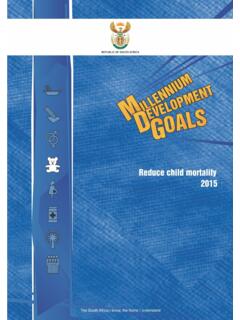Transcription of Millennium Development Goals 5: Improve …
1 I Millennium Development Goals 5: Improve maternal health 2015 / Statistics South Africa Published by Statistics South Africa, Private Bag X44, Pretoria 0001 Stats SA Library Cataloguing-in-Publication (CIP) Data Millennium Development Goals 5: Improve maternal health / Statistics South Africa, Pretoria: Statistics South Africa, 2015 34pp ISBN: 978-0-621-43866-6 ii TABLE OF CONTENTS maternal mortality ratio .. 6 Proportion of births attended by skilled health personnel .. 9 Contraceptive prevalence rate .. 10 Adolescent birth rate .. 12 Antenatal care coverage (at least one visit and at least four visits) .. 13 Unmet need for family planning.
2 13 Prevention of mother-to child-transmission (of HIV for mothers) .. 14 List of Tables .. iii List of Figures .. iii List of Acronyms .. iv Executive summary .. v 1 Introduction .. 1 2 Targets, indicators and data sources .. 3 3 Status at a Glance .. 4 4 MDG 5 targets and progress .. 6 5 Policies and programmes .. 17 6 Towards Sustainable Development Goals (SDGS) .. 22 7 Conclusion and recommendations .. 23 8 References .. 26 iii LIST OF TABLES Table 1: Summary of MDG 5 indicators and data sources .. 3 Table 2: Summary of goal 5 indicators, current status and target achievability .. 4 Table 3: maternal mortality ratio .. 6 Table 4: Proportion of births attended by skilled health personnel.
3 9 Table 5: Percentage of births in health facilities by province, 2010 2014 .. 10 Table 6: Contraceptive prevalence rate .. 10 Table 7: Estimates of the couple year protection rate (per cent), 2010 2014 .. 11 Table 8: Adolescent birth rate .. 12 Table 9: National and provincial estimates of under 18 facility deliveries (per cent), 2010 2014 .. 12 Table 10: Antenatal care coverage .. 13 Table 11: National and provincial estimates of antenatal care coverage (first visit), 2010 2014 .. 13 Table 12: Prevention of mother-to-child transmission of HIV .. 14 Table 13: Antenatal first visit before 20 weeks .. 15 Table 14: Per cent antenatal client initiated on antiretroviral treatment.
4 16 LIST OF FIGURES Figure 1: Underlying causes of maternal deaths in South Africa .. 2 Figure 2: maternal mortality ratio in South Africa, 1998 7 Figure 3: Various estimates of maternal and pregnancy related mortality ratios for South Africa .. 7 Figure 4: Institutional maternal mortality ratios (2002 2012) .. 8 Figure 5: Percentage of births in health facilities (2010 2014) .. 9 Figure 6: Trends in antenatal HIV prevalence in South Africa, 1994 2012 .. 14 iv LIST OF ACRONYMS AIDS Acquired Immune Deficiency Syndrome AMTSL Active Management of the Third Stage of Labour ART Anti-Retroviral Therapy CARMMA Campaign for the Accelerated Reduction in maternal and Child Mortality in Africa CPR Contraceptive Prevalence Rate CS Caesarean Section CYP Couple Year Protection Rate DHIS District Health Information System DHS Demographic and Health Survey HAART Highly Active Antiretroviral Therapy HADCC Health Data Advisory Coordination Committee HIV Human Immunodeficiency Virus iMMR Institutional maternal Mortality Ratio MDG Millennium Development Goal MMR maternal mortality ratio MNCWH maternal , Newborn.
5 Child and Women's Health NCCEMD National Committee on the Confidential Enquiries into maternal Deaths NDOH National Department of Health NPR National Population Register PMTCT Prevention of Mother To Child Transmission RMS Rapid mortality Surveillance TB Tuberculosis WHO World Health Organisation v EXECUTIVE SUMMARY Introduction South Africa has made significant progress with regard to the improvement of maternal health and the reduction of maternal mortality in the last two decades. In 2010, it was estimated that nearly 3 000 South African women died during childbirth, but latest estimates show that maternal deaths have halved.
6 The PMTCT programme, which aims to ensure that HIV-infected women remain healthy and give birth to healthy children, has been expanded rapidly; and many more women have benefited from this programme as a result of both the expansion of the eligibility criteria (as the services are offered to women when they are still healthy), and through integration of PMTCT services into routine antenatal services offered in all healthcare facilities in the country. Modern contraceptive methods are freely available in public health facilities, and there has been an overall improvement in access to reproductive health.
7 The 1996 Choice on Termination of Pregnancy Act made medical and surgical abortion free for all women of any age at public healthcare facilities, and this has seen an increase in the uptake of safe pregnancy terminations. However, many women still die during childbirth. Despite the expansion of the PMTCT programme, HIV infection in pregnancy is the major contributing factor to maternal deaths, accounting for more than 30% of all these deaths. The national antenatal prevalence of HIV was in 1994, but that increased to 30% in 2004, and has since plateaued and stabilised. Avoidable factors, missed opportunities, poor quality of care and the lack of training of front-line healthcare workers have all been found to contribute to maternal deaths from all causes.
8 This report assesses South Africa s progress towards achieving the Millennium Development Goal (MDG) 5, namely to Improve maternal health as outlined in the Millennium Declaration. MDG 5 has two targets: A. To reduce by three-quarters, between 1990 and 2015 , the maternal mortality ratio. South Africa s target for MMR was thus 38 deaths per 100 000 live births for 2015 , from a baseline of 150/100 000 in 1990; and B. To achieve by 2015 , universal access to reproductive health. The indicators for the first target (which we will refer to as target 5A), are: the maternal mortality ratio and the proportion of births attended by skilled healthcare personnel.
9 The indicators for target 5B are: the contraceptive prevalence rate; adolescent birth rate; antenatal care coverage; and the unmet need for family planning. Proxies for MDG indicators are used where recent data are not available. MDG 5 targets and progress maternal mortality ratio (MMR) The baseline maternal mortality ratio was 150 maternal deaths per 100 000 live births at the start of measuring MDG 5 in 1998. MMR initially increased to 311/100 000 in 2009, but by it declined to vi 270/100 000 by 2010. This decline has been sustained and the latest estimate of MMR is measured at 141/100 000 by the year 2013. Proportion of births attended by skilled healthcare personnel The proportion of births attended by skilled healthcare personnel was 84% in 1998 and increased to 91% in 2003.
10 These estimates were made from the population based Demographic and Health Survey (DHS), which was last conducted in 2003. In the absence of DHS data, the percentage of births in public healthcare facilities (facility delivery rate) obtained from the District Health Information System (DHIS) is used as a proxy. The proportion of all births that occur in public healthcare facilities has increased steadily from a baseline of 67% in 2003, to in 2010 and in 2014. (It should be noted that this figure excludes births that occur in private healthcare facilities, and is therefore likely to underestimate the true figure).















